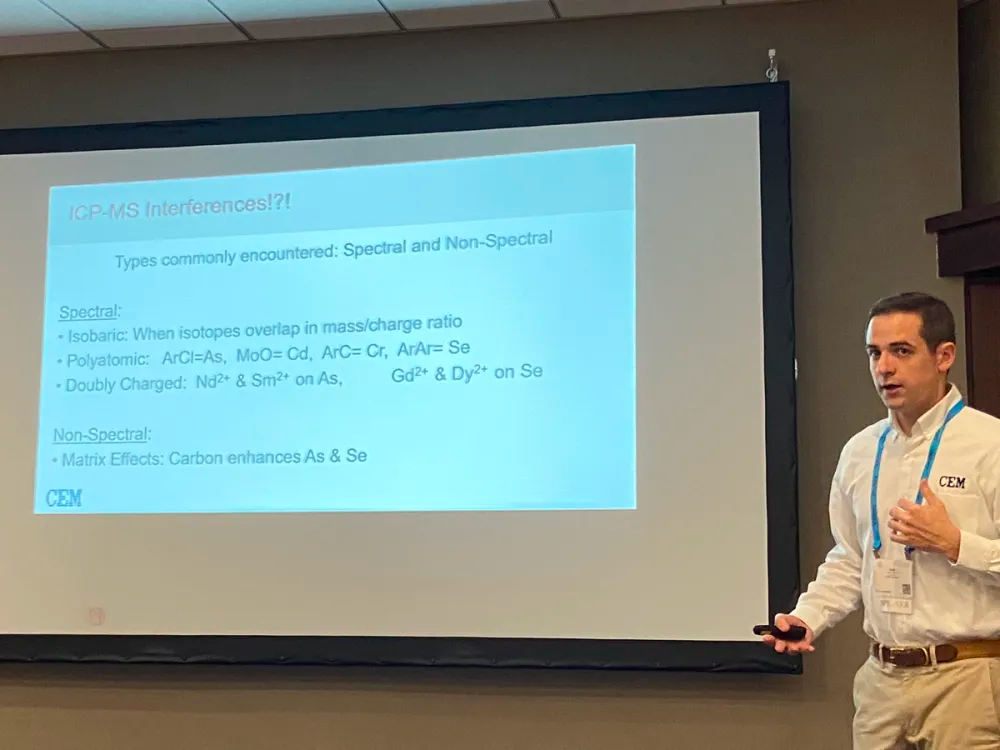EAS Coverage: Challenges Experienced in Cannabis Heavy Metal Analysis: Insights from Analytical Chemist Sam Heckle
Sam Heckle, an analytical chemist from CEM Corporation, addressed the challenges faced in analyzing cannabis samples for toxic heavy metals in his presentation on Day 3 at the Eastern Analytical Symposium (EAS), titled “The Importance of Digestion Temperature on Trace Metals Analysis”. He highlighted that with the legalization of cannabis in many states, testing for safety, especially heavy metals, such as arsenic, cadmium, lead, and mercury, is crucial.
Heckle said in his presentation, “Pretty much all states are testing for what we call the ‘Big Four’, which are arsenic, cadmium, lead, and mercury. A handful of other states will test for a handful of other elements as well and those include selenium and chromium.”
In order to get the analysis, it involves using ICP mass spectrometry (ICP-MS) to detect low concentrations of heavy metals. Heckle mentioned that “in order to put our solid samples into the ICP mass spectrometry, we have to get them into a liquid solution.” He then added that “the most common way these days to do that is by acid digestion, and more specifically microwave acid digestion because it's a lot faster and more complete. Typically, whenever we are acid digesting things, we want the solution to look like water afterwards. We're looking for colorless and particle free.”
He discussed two main interferences in ICP-MS: spectral (isobaric and polyatomic) and non-spectral interferences. Attendees were taught how isobaric interferences are manageable, polyatomic interferences, such as argon fluoride with arsenic, and can be challenging. Heckle emphasized the importance of using hydrochloric acid (HCL) to stabilize mercury and prevent interference.
Sam Heckle presenting his talk, titled "The Importance of Digestion Temperature on Trace Metals Analysis", at the 2023 Eastern Analytical Symposium (EAS).

The presentation delved into the difficulties in complete digestion, highlighting the impact of temperature and time. Heckle discussed a study he conducted where cannabis samples were digested at three different temperatures (180, 210, and 240 degrees Celsius) which were used to analyze for heavy metals. He recommended that 210 degrees Celsius was the most effective, as higher temperatures led to venting issues and potential loss of elements. Heckle commented that by going down to 180 degrees Celsius that he, “started getting elevated arsenic recovers and that is due to the residual carving, enhancing the signal for arsenic.” Selenium had a similar outcome but was a little higher but was lower than arsenic. Selenium and arsenic showed higher numbers than what is typically preferred.
To combat interference, Heckle recommended using internal standards, specifically Thallium-125 (Te 125) for arsenic and selenium, and scandium for other elements. He encouraged to move with caution and not use bismuth due to its interference and also suggested avoiding isopropyl alcohol (IPA) to your internal standards. “Adding IPA to your internal standards is not always going to be as effective as people make it out to be,” said Heckle.
Heckle also shared data with EAS attendees on the recovery of known concentrations (NIST SRM) and the impact of spiking unknown samples to assess recovery rates. The results emphasized the importance of careful method development to minimize interference and improve accuracy in cannabis sample analysis.
In conclusion, Heckle’s presentation provided valuable insights into the challenges of heavy metal analysis in cannabis samples, offering practical recommendations for optimal digestion, interference correction, and the use of internal standards to ensure reliable results.
TD-GC–MS and IDMS Sample Prep for CRM to Quantify Decabromodiphenyl Ether in Polystyrene Matrix
April 26th 2024At issue in this study was the certified value of decabromodiphenyl ether (BDE 209) in a polystyrene matrix CRM relative to its regulated value in the EU Restriction of Hazardous Substances Directive.
LC–MS/MS-Based System Used to Profile Ceramide Reactions to Diseases
April 26th 2024Scientists from the University of Córdoba in Córdoba, Spain recently used liquid chromatography–tandem mass spectrometry (LC–MS/MS) to comprehensively profile human ceramides to determine their reactions to diseases.
High-Throughput 4D TIMS Method Accelerates Lipidomics Analysis
April 25th 2024Ultrahigh-pressure liquid chromatography coupled to high-resolution mass spectrometry (UHPLC-HRMS) had been previously proposed for untargeted lipidomics analysis, but this updated approach was reported by the authors to reduce run time to 4 min.